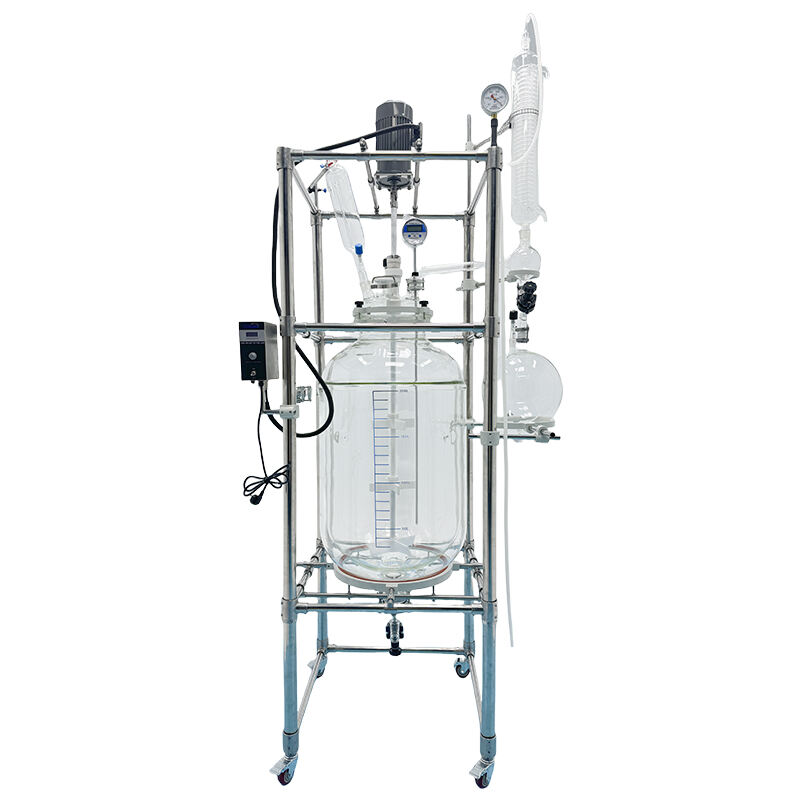Jacketglazen reactoren zijn gespecialiseerde vaaten ontworpen voor nauwkeurige temperatuurregeling tijdens chemische reacties. Bedrijvenvertrouwen op deze reactoren om consistentie te waarborgen in processen zoals synthese en kristallisatie. Hun transparante ontwerp staat real-time monitoring toe, wat de nauwkeurigheid verbetert. In 2025 hebben ontwikkelingen in materialen en automatisering deze reactoren efficienter en duurzamer gemaakt dan ooit tevoren.
Toepassingen van Gejaste Glas Reactoren
Gejaste glazen reactoren spelen een cruciale rol in de chemische en farmaceutische industrieën. Deze reactoren bieden nauwkeurige temperatuurcontrole, wat essentieel is voor processen zoals synthese, kristallisatie en destillatie. Onderzoekers gebruiken ze om nieuwe verbindingen te ontwikkelen en de reactieomstandigheden te optimaliseren. Farmaceutische bedrijven vertrouwen op deze reactoren om geneesmiddelen en tussenproducten van hoge zuiverheid te produceren. Hun transparante ontwerp stelt wetenschappers in staat om reacties visueel te volgen, wat zorgt voor nauwkeurigheid en veiligheid. Het vermogen om consistente temperaturen te handhaven maakt ze ook ideaal voor het opschalen van productie van laboratorium- naar industriële niveaus.
Milieu wetenschappers gebruiken gejaste glazen reactoren om chemische reacties onder gecontroleerde omstandigheden te bestuderen. Deze reactoren helpen bij het simuleren van scenario's uit de echte wereld, zoals de afbraak van verontreinigende stoffen of waterbehandelingsprocessen. Onderzoekers kunnen variabelen zoals temperatuur en druk aanpassen om te observeren hoe verschillende factoren reacties beïnvloeden. Deze mogelijkheid ondersteunt de ontwikkeling van milieuvriendelijke oplossingen voor afvalbeheer en vervuilingsbestrijding. De veelzijdigheid van de reactoren maakt ze een waardevol hulpmiddel voor het bevorderen van milieuwetenschappelijk onderzoek en testen.
In 2025, jacketed glass reactors vinden nieuwe toepassingen in geavanceerde velden. Biotechnologiebedrijven gebruiken ze voor fermentatie- en celkweekprocessen. De nauwkeurige temperatuurregeling van de reactors ondersteunt de groei van micro-organismen en cellen voor de productie van biobased producten. In de voedsel- en drankenindustrie helpen ze bij smaakextractie en ingrediëntentests. Bovendien stellen vooruitgangen in automatisering en IoT-integratie op afstand toezicht en controle mogelijk, waardoor hun bruikbaarheid in slimme laboratoria en productie-installaties wordt vergroot.
Belangrijke componenten van jacketed glass reactors
De reactorvessel vormt de kern van jacketed glasreactoren. Het houdt het reactiemengsel vast en biedt een transparant uitzicht op het proces. De jacket omringt de vessel en maakt nauwkeurige temperatuurregeling mogelijk door verwarmings- of koelvloeistoffen te circuleren. Fabrikanten ontwerpen deze vessels met borosilicaatglas, dat bestand is tegen thermische schokken en chemische corrosie. De efficiëntie van de jacket zorgt voor een uniforme warmteverdeling, wat essentieel is voor het handhaven van de stabiliteit van de reactie.
Roerassen en agitatoren mengen de reactienet inhoud om uniformiteit te waarborgen. Deze componenten verbeteren de warmteoverdracht en voorkomen sedimentatie. Agitatoren zijn verkrijgbaar in verschillende ontwerpen, zoals anker-, turbine- of propellertypes, afhankelijk van de procesvereisten. De roeras is verbonden met een motor, die instelbare snelheden biedt voor nauwkeurig mengen. Deze functie is cruciaal voor het bereiken van consistente reactieresultaten.
Temperatuurprobes monitoren de interne omstandigheden van de reactor. Deze sensoren bieden realtime gegevens, waardoor gebruikers optimale reactietemperaturen kunnen handhaven. Geavanceerde probes in 2025 bieden hogere nauwkeurigheid en snellere responstijden. Ze integreren naadloos met digitale controlesystemen, wat zorgt voor nauwkeurige aanpassingen. Betrouwbare temperatuurmonitoring is cruciaal voor processen die strikte thermische regulatie vereisen.
Verwarmings- en koelsystemen reguleren de temperatuur van de circulerende vloeistof in de jas. Deze systemen omvatten koelmachines, verwarmers of thermostaten, afhankelijk van het gewenste temperatuurbereik. Moderne systemen in 2025 beschikken over energiezuinige ontwerpen en geautomatiseerde controles. Ze stellen gebruikers in staat om temperatuurprofielen te programmeren voor complexe reacties. Efficiënt thermisch beheer zorgt voor consistente resultaten en vermindert het energieverbruik.
De Juiste Gejaste Glazen Reactor Kiezen
Capaciteit en Volume Overwegingen
Het selecteren van de juiste capaciteit is cruciaal bij het kiezen van een jacketed glasreactor. Het volume van de reactor moet overeenkomen met de schaal van het beoogde proces. Laboratoriumexperimenten vereisen vaak kleinere vaten, variërend van 1 tot 5 liter. Industriële toepassingen kunnen echter reactors vereisen met capaciteiten van meer dan 50 liter. Te grote reactors kunnen leiden tot inefficiënties, terwijl te kleine reactors de productie kunnen beperken. Gebruikers moeten ook rekening houden met de mogelijkheid om de operaties op te schalen. Een reactor die toekomstige groei kan accommoderen, kan op de lange termijn kosten besparen.
Materiële verenigbaarheid
De materialen die worden gebruikt in jacketed glasreactoren moeten bestand zijn tegen de chemicaliën die bij het proces betrokken zijn. Borosilicaatglas is de standaardkeuze vanwege de weerstand tegen thermische schokken en chemische corrosie. Gebruikers moeten echter de compatibiliteit met specifieke oplosmiddelen, zuren of basen verifiëren. Voor zeer reactieve stoffen kunnen extra coatings of voeringen nodig zijn. Het waarborgen van materiaalcompatibiliteit voorkomt schade aan de reactor en behoudt de integriteit van de reactie.
Veiligheidsfuncties en certificaten
Veiligheid is een topprioriteit bij het werken met jacketed glasreactoren. Hoogwaardige reactoren bevatten functies zoals drukontlastingskleppen, versterkt glas en veilige afdichtingen. Deze componenten beschermen gebruikers tegen ongevallen tijdens hoge druk- of vacuümoperaties. Certificeringen, zoals CE- of ISO-normen, geven aan dat de reactor voldoet aan de veiligheidsvereisten van de industrie. Kopers moeten reactoren met deze certificeringen prioriteit geven om naleving en betrouwbaarheid te waarborgen.
Budget en Langetermijnwaarde
Kosten zijn een belangrijke factor, maar ze mogen de kwaliteit en functionaliteit niet overschaduwen. Hoewel budgetvriendelijke opties aantrekkelijk kunnen lijken, missen ze vaak geavanceerde functies of duurzaamheid. Investeren in een hoogwaardige reactor kan de onderhoudskosten verlagen en de levensduur verlengen. Kopers moeten ook de beschikbaarheid van vervangingsonderdelen en klantenservice evalueren. Een reactor die langdurige waarde biedt, zal betere rendementen op investering opleveren.
Conclusie
Gejacketed glazen reactors blijven onmisbare hulpmiddelen in laboratoria en industrieën. Hun veelzijdigheid ondersteunt diverse toepassingen, terwijl vooruitgangen in automatisering en duurzaamheid de efficiëntie verbeteren. Juiste onderhoud zorgt voor langdurige betrouwbaarheid. Naarmate industrieën evolueren, zullen deze reactors een cruciale rol spelen in innovatie, met precieze controle en aanpassingsvermogen voor toekomstige wetenschappelijke en industriële doorbraken.

